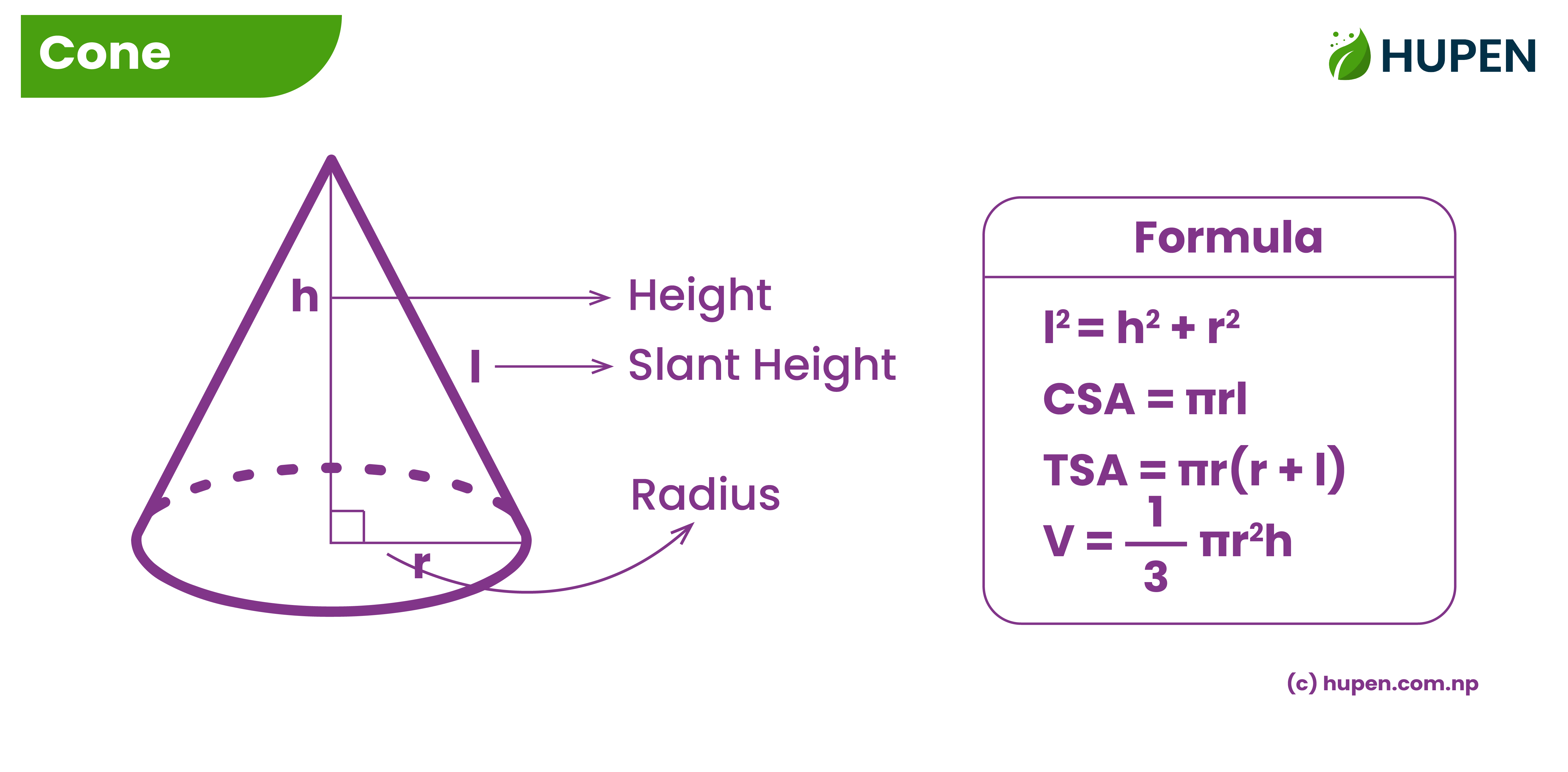
Introduction to Pyramid
1. What is a Pyramid?
A pyramid is a solid 3D shape with a flat base that is a polygon, and triangular sides that meet at a single point called the apex (or top).
Hence, A pyramid is a 3D solid shape that has:
a. A Polygon base (like a square, triangle, or rectangle). We will be studying the square base pyramid in this course.
b. Triangular faces that meet at a common point called the apex (or vertex).
2. 🏛️ Examples in Real Life:
- The Pyramids of Egypt (Square base),
- A tent (Triangular base),
- An ice cream cone with a flat polygonal base.
3. Parts of a Pyramid:
- Base: The flat bottom surface (can be any polygon).
- Lateral Faces: The triangle faces that meet at the apex.
- Apex (Vertex): The top point where all triangle faces meet.
- Slant Height (l): The diagonal height from the base edge to the apex.
- Height (h): The vertical distance from the base center to the apex.
Formulae for the Pyramid
Let us consider, a = length of the base, h = Vertical height and l = slant height of the pyramid.
1. Relation between Length of Base(a), Height(h) and Slant Height(l):
The relation between length of the base, height, and slant height can be established according to the Pythagorean Theorem.
2. Lateral Surface Area (LSA):
The total area of only the triangular side faces of the pyramid (not including the base) is called the Lateral Surface Area.
3. Total Surface Area (TSA):
The total area of all faces, including the base and the lateral faces is called the Total surface area.
4. Volume of a Pyramid:
The space inside the pyramid is called the volume of a pyramid.
Introduction to Cone
What is Cone?
A 3D solid shape with a circular flat base joined to a curved side that ends at an apex point is called a cone. In summary,
- Has a circular base,
- Comes to a pointed tip called the vertex,
- Has a curved surface connecting the base to the vertex.
Example: It looks like an ice cream cone or a party hat.
Parts of a Cone:
- Radius (r): Distance from the center to the edge of the base.
- Height (h): Perpendicular distance from the base to the vertex.
- Slant Height (l): Distance from the edge of the base to the vertex (along the cone's side).

Formulae for the Cone
Let us consider, r = radius of the base, h = Vertical height and l = slant height of the cone.
1. Relation between Radius(r), Height(h) and Slant Height(l):
The relation between radius, height and slant height can be established according to the Pythagorean Theorem.
2. Curved Surface Area (CSA):
The area of the curved (side) part of the cone is called curved surface area. It is represented by \(CSA\).
3. Total Surface Area (TSA):
The curved surface area plus the base area is called Total surface area. It is represented by \(TSA\).
4. Volume of a Cone
Volume is the space inside the cone.
Combined Solid Objects
Combined solids are 3D shapes formed by joining two or more basic solid shapes like cylinder, cone, sphere, prism, pyramid etc. These solids often appear in real life (e.g., an ice cream cone or water tank, pencil) and are useful in geometry problems involving surface area and volume.
Important Notes:
When combining two solids:
- Total Surface Area (TSA) depends on which surfaces are visible. Usually, common or joined surfaces are not counted in the TSA.
- Volume (V) is always added:
1. Cylinder and Cone (cone on top of cylinder)
Total Surface Area (TSA): If you add the area of the base (cylinder), CSA of the cylinder, and CSA of the cone, you get the Total Surface Area (TSA) of the given combined object.
Volume (V): If you add the volume of the cylinder and cone, you get the volume of the combined object.
Formulae:
Let us consider, \(h_1\) = height of cylinder, \(h_2\) = height of cone, \(r\) = common radius, \(l\) = slant height of cone.
2. Cone and Hemisphere (hemisphere at top of cone)
Total Surface Area (TSA): If you add the CSA of the cone and the CSA of the hemisphere, you get the Total Surface Area (TSA) of the given combined object.
Volume (V): If you add the volume of the cone and hemisphere, you get the volume of the combined object.
Formulae:
Let us consider, \(l\) = slant height of the cone, \(h\) = height of the cone and \(r\) = radius of the circle.
3. Cylinder and Hemisphere (hemisphere on top of cylinder)
Total Surface Area (TSA): If you add the area of the base (cylinder), CSA of the cylinder, and CSA of the hemisphere, you get the Total Surface Area (TSA) of the given combined object.
Volume (V): If you add the volume of the cylinder and hemisphere, you get the volume of the combined object.
Formulae:
Let us consider, \(h\) = height of cylinder, \(r\) = common radius.
4. Cone and Cone (joined at bases)
Total Surface Area (TSA): If you add the CSA of the first cone and the second cone, you get the Total Surface Area (TSA) of the given combined object.
Volume (V): If you add the volume of the first cone and the second cone, you get the volume of the combined object.
Formulae:
Let us consider, \(h_1\) = height of first cone, \(h_2\) = height of second cone, \(l_1\) = slant height of first cone, \(l_2\) = slant height of first cone, \(r\) = common radius.
5. Prism and Pyramid (same base, pyramid on top of prism)
Total Surface Area (TSA): If you add the area of base, CSA of the prism (square prism) and CSA of the pyramid , you get the Total Surface Area (TSA) of the given combined object.
Volume (V): If you add the volume of the Prism and the pyramid, you get the volume of the combined object.
Formulae:
Let us consider, \(h_1\) = height of prism, \(h_2\) = height of pyramid, \(l\) = slant height of pyramid, \(a\) = length of the base.
Share Now
Share to help more learners!

